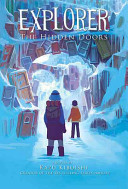2018 School Spending Survey Report
Explorer: The Hidden Door
, ed. illus. by Kazu Kibuishi et al. 128p. (Explorer: Bk. 3). Abrams/Amulet. 2014. Tr $19.95. ISBN 9781419708824; pap. $10.95. ISBN 9781419708848. LC 2014938941.
COPY ISBN
A collection of seven diverse, engaging stories by some of today’s most popular graphic artists—Kazu Kibuishi, Jason Caffoe, Jen Wang, Faith Erin Hicks, Steve Hamaker, Johane Matte, Jen Breach, and Douglas Holgate. The concept of hidden doors allows for many thematic opportunities, including doors that keep secrets behind them, doors that remain locked until certain conditions are met, doors that open into new realms, and doors that effect a transfiguration. Lush, colorful artwork features each illustrator’s unique style. Fun and inventive details abound, such as the robot body given to a goldfish in Hamaker’s “FishNChips in Spring Cleaning.” The tales’ settings vary from the quotidian to the extreme and are always convincingly established by the illustrations. From the ice mountain in Kibuishi’s “Aster Crane” and the desert tomb in Matte’s “Mastaba,” to the elementary school in Wang’s “Luis 2.0,” readers will feel as though they are accompanying the characters on their adventures.
This third book in the series (Explorer: The Mystery Boxes; Explorer: The Lost Islands) follows the same successful formula: a handful of graphic artists start with the same topic, each coming up with a unique story. The wide variety of genres and illustration styles keeps the theme fresh and intriguing; here's hoping Kibuishi continues to explore further mysterious topics.
ALREADY A SUBSCRIBER? LOG IN
We are currently offering this content for free. Sign up now to activate your personal profile, where you can save articles for future viewing




Be the first reader to comment.
Comment Policy:
Comment should not be empty !!!